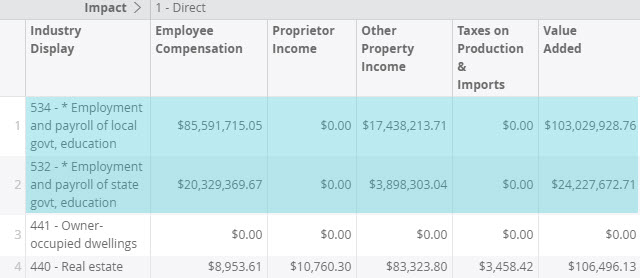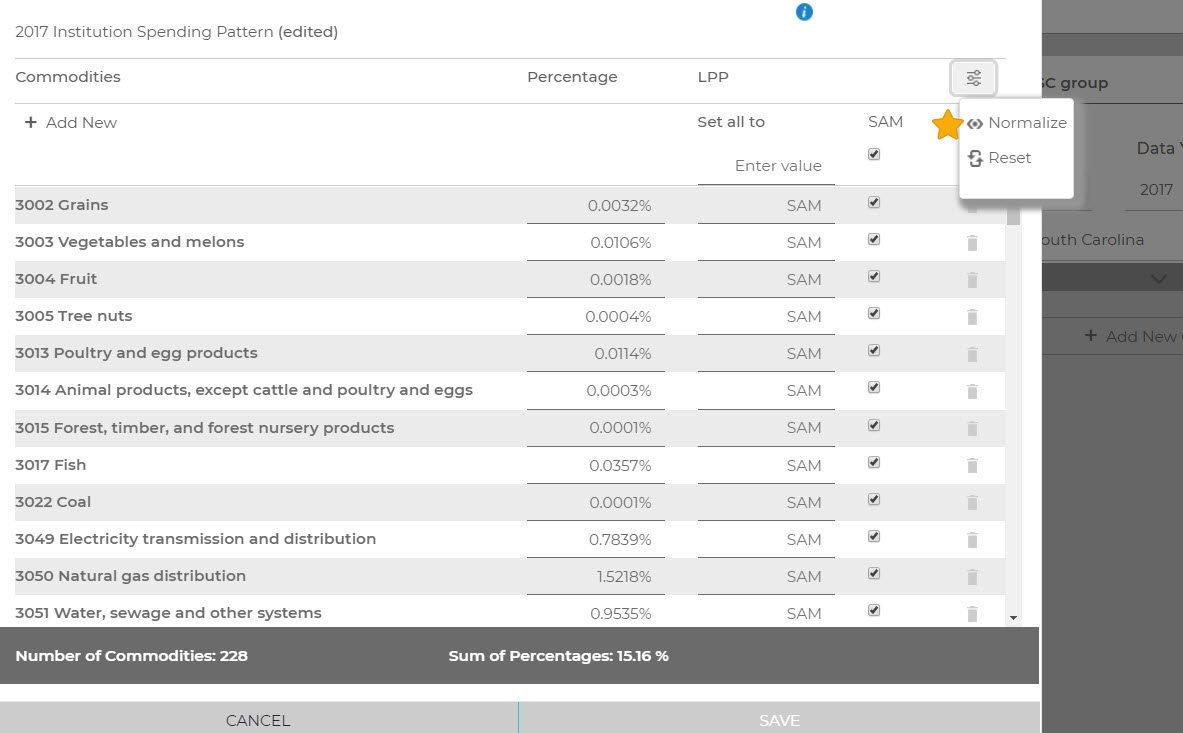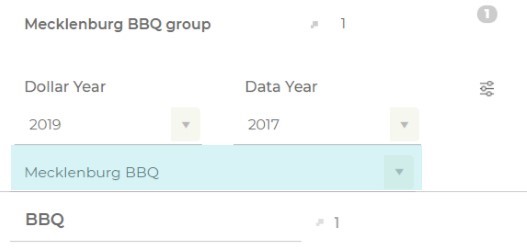Social Accounts
INTRODUCTION:
The Social Account Reports Table and the Balance Sheets Table both contain a wealth of information about the specified study region. Provided below are definitions and descriptions of many of the terms and categories found within the tables.
REPORTS:
Commodity Summary
- Industry Commodity Production = the total output of this commodity that is produced by industries. Some commodities are produced by more than one industry – this value includes the sum of the production of this commodity by all industries.
- Institutional Commodity Production = the total output of this commodity that is produced by institutions (i.e., produced by Government or taken out of Inventory).
- Total Commodity Supply = Industry Commodity Production + Institutional Commodity Production.
- Net Commodity Supply = Total Commodity Supply – Foreign Exports of the commodity from the region. Foreign Exports can be found by selecting View By: Commodity Trade.
- Intermediate Commodity Demand = total demand for this commodity by industries.
- Institutional Commodity Demand = total demand for this commodity by institutions (Inventory, Government, Households, Capital).
- Total Gross Commodity Demand = Intermediate Commodity Demand + Institutional Commodity Demand. The term “gross” refers to the fact that these figures include imports (both foreign and domestic) of the commodity into the region.
- Domestic Supply/Demand Ratio = the percentage of total local demand for the commodity that could possibly be met by local production. It is calculated by dividing Net Commodity Supply by Total Gross Commodity Demand, constrained to a maximum of 100%.
- Average RPC = the proportion of local demand for the commodity that is currently met by local production. It is “average” in the sense that there is just one RPC per commodity, so all industries and institutions are assumed to purchase that commodity locally at the same rate.
- Average RSC = the proportion of local supply of the commodity that goes to meet local demand.
Commodity Trade
- Foreign Exports = output value of local production of this commodity that is exported abroad.
- Domestic Exports = output value of local production of this commodity that is exported to other regions of the U.S.
- Total Exports = Foreign Exports + Domestic Exports
- Intermediate Imports = value of imports (both foreign and domestic) into the region for use by industries as an input.
- Institutional Imports = value of imports (both foreign and domestic) into the region for final use by institutions (Inventory, Government, Households, Capital).
- Total Imports = Intermediate Imports + Institutional Imports.
- Foreign Export Proportion = the percentage of Total Exports that go to foreign countries. It is calculated by dividing Foreign Exports by Total Exports.
Institution Local Commodity Demand
This table lists each institution’s demand for local production of each commodity. The sum across all institutions for a particular commodity is the total local institutional demand for local production of that commodity. Foreign Exports and Domestic Exports are the same as reported in the Commodity Trade screen.
Household Local Commodity Demand
This table lists each Household type’s demand for local production of each commodity. The sum across all Household types for a particular commodity is equivalent to the “Households” value on the Institution Local Commodity Demand screen.
Government Local Commodity Demand
This table lists each Government type’s demand for local production of each commodity. The sum across all six Government types for a particular commodity is equivalent to the “Government” value on the Institution Local Commodity Demand screen.
BALANCE SHEETS:
Industry Balance Sheet
On all of the Balance Sheets, the default Industry or Commodity is always Oilseeds. In order to see the Industry or Commodity of interest, click the Filter button and choose the appropriate Sector. Click Run to have the model filter for that Sector.
Commodity Production
- Commodity Production = the output value of each of the commodities produced by this industry.
- Market Share = the proportion of Commodity Production that is produced by this industry. If there is more than one producer of a commodity, this industry’s Market Share for that commodity will be less than 100%.
- Byproduct Coefficient = the proportion of this industry’s total industry output that is dedicated to each commodity. If the industry makes more than one commodity, each Byproduct Coefficient will be less than 100%.
Commodity Demand
- RPC = the proportion of local demand for the commodity that is currently met by local production. This is the same value as that found in the View By: Commodity Summary screen.
- Gross Absorption = the proportion of Total Industry Output for this industry that goes toward purchases of each commodity. Gross Absorption is calculated as Gross Inputs/Total Industry Output. Total Gross Absorptions will be less than one, with the remainder of Total Industry Output going toward Value-Added.
- Gross Inputs = the value that this industry spends on each commodity.
- Regional Absorption = the proportion of Total Industry Output for this industry that goes toward local purchases of each commodity. Regional Absorption can be calculated as Gross Absorption * RPC.
- Regional Inputs = the value that this industry spends locally on each commodity. Regional Inputs can be calculated as Gross Inputs * RPC.
Value Added
- Value Added Coefficient = the proportion of Total Industry Output that goes toward each category of Value-Added. Each Value Added Coefficient can be calculated by dividing Value Added by Total Industry Output. The Total Value-Added Coefficient + Total Gross Absorption = 1.00.
- Value Added = the dollar value paid to each category of Value Added.
Commodity Balance Sheet
Industry-Institutional Production
- Industry Production = the total output of this commodity that is produced by the industry listed in each row.
- Regional Market Share = the proportion of Industry Production that is produced by the industry/institution listed in each row. If there is more than one producer of this commodity, each Market Share will be less than 100%.
- (Byproduct) Coefficient = the proportion of each industry’s total industry output that is dedicated to this commodity. If the industry/institution makes more than one commodity, the Byproduct Coefficient will be less than 100%.
Industry Demand
- RPC = the proportion of local demand for the commodity that is currently met by local production. This is the same value as that found in the View By: Commodity Summary screen.
- Gross Absorption = the proportion of Total Industry Output for each industry that goes toward purchases of this commodity. Gross Absorption is calculated as Gross Inputs/Total Industry Output.
- Gross Inputs = the value that each industry spends on this commodity.
- Regional Absorption = the proportion of Total Industry Output for each industry that goes toward local purchases of this commodity. Regional Absorption can be calculated as Gross Absorption * RPC.
- Regional Inputs = the value that each industry spends locally on this commodity. Regional Inputs can be calculated as Gross Inputs * RPC.
Institutional Demand
- RPC = the proportion of local demand for the commodity that is currently met by local production. This is the same value as that found in the View By: Commodity Summary screen. Note that if institutions purchase this commodity from local retailers, the retail margin portion of the purchase will have a high RPC; however, the producer portion of the purchase price will have a low RPC if there is little local production of that commodity.
- Gross Demand = the amount that each institution spends on this commodity.
- Regional Demand = the amount that each institution spends locally on this commodity. Note that this value has already been margined (that is, if the institution buys this commodity from a retailer, this value only shows the portion of that purchase amount that goes to local producers of the commodity). Regional Demand can be calculated as Gross Demand * RPC.
IxC SOCIAL ACCOUNTING MATRIX:
Aggregate IxC SAM& Detail IxC SAM:
Details on these tables can be found in the article: Summary Description of Elements of the IxC Social Accounting Matrix.
SORTING:
The title bar displayed across the top of each Study Area View By contains buttons that can change the viewing attributes of the table. The bar shown is for Regions Commodity Summary.
Most column titles act as sorting buttons. Initially most views are sorted by Sector code in ascending value (first row is 0 last row is 546). To change the way all fields in the table are arranged, click on the title of the desired column. All data in the table will be sorted in descending order (highest values listed at the top of the table) relative to the column title. To change how the data is sorted, click on another field. When the view has been sorted by a column other than Commodity Code, the selected column title will appear with an arrow to its right indicating that the table has been sorted by this column header.
DOWNLOADING:
The export function allows data to be exported directly to a PDF or CSV file by clicking on the gear icon.














 HOUSEHOLDS:
HOUSEHOLDS: INDUSTRIES:
INDUSTRIES: GOVERNMENT:
GOVERNMENT: CONSTRUCTION:
CONSTRUCTION:

























 Student Spending
Student Spending Tourist Spending
Tourist Spending Business Spending
Business Spending


















